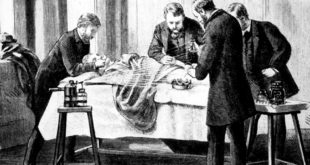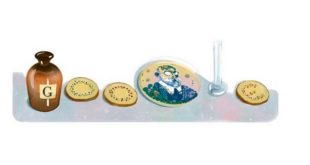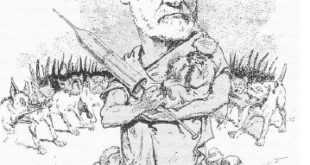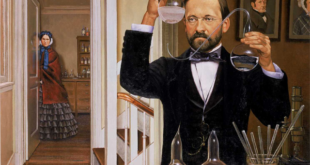by Louis Pasteur (with the Collaboration of Mr. Chamberland and Mr. Roux)
Originially published in the Comptes Rendus de l’Academie des Science 92:1378-1383, June 13, 1881.
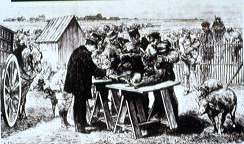
In a lecture which I presented to the Academy last February 28, the purpose of which was to discover a method for preparation of attenuated anthrax, I spoke on behalf of myself and my young collaborators:
Each one of our attenuated anthrax microbes is a vaccine for the virulent microbe, that is to say, an adapted virus which produces a more benign variety of disease. After all, what could be easier than to find, among the offspring of the anthrax microbe, some adapted ones which can give the anthrax fever to sheep, cows and horses without having them perish? We have practiced this procedure with great success in sheep. As soon as the time comes for rounding up the herds in Beauce, we will try to apply this method on a large scale.
Anthrax is responsible for the loss of many millions of animals every year in France. Consequently, it would be desirable to be able to save the ovine, bovine,and equine species if the above method of vaccination can be offered to us almost immediately, and without having to wait for the sheep round-up.
Last April, the president of the Agriculture Society of Melun, Baron de la Rochette, proposed that I conduct a decisive experiment to obtain the results of which I recently presented to the Academy. I was pleased to accept, and on April 28 we met and agreed upon to the following:
- The Agriculture Society of Melun will put sixty sheep at the disposal of Mr. Pasteur.
- Ten of these sheep will not undergo any treatment.
- At an interval of twelve to fifteen days, twenty-five of these sheep will receive two vaccinations of unequally attenuated anthrax.
- These twenty-five sheep will be inoculated by very virulent anthrax at the same time as the remaining twenty-five (uninoculated sheep), after a new interval of twelve or fifteen days. All twenty-five sheep that were not vaccinated will perish; all twenty-five that were vaccinated will resist infection, and we will ultimately compare them with the ten untreated sheep above. This is to show that vaccination does not prevent the sheep from returning to a normal state.
- After the general inoculation of very virulent microbe to the two batches of vaccinated and unvaccinated sheep, the fifty sheep will remain together in the same cattle shed; one will distinguish one from the other by punching a hole in the ear of the twenty-five vaccinated sheep.
- All the sheep which will die of the anthrax will be buried in distinct pits neighboring each other in a pallisaded enclosure.
- In May 1882, we will put twentyfive new sheep — which have never been subjected to these treatments — in the enclosure in question toprove that the new sheep can be infected spontaneously by the anthrax microbes brought back to the surface of the ground by earthworms.
- Another twenty-five other new sheep will be herded a few meters away from the enclosure described above. No animals infected with anthrax have ever been interred in this new area, and thus this experiment will show that none of these new sheep will contract anthrax.
Addendum to the preceding agreement:
When the president of the Agriculture Society of Melun asked that these experiments be extended to cows as well, I responded that we were ready to do so. However, I would like to inform the Society that, at the moment, the vaccination experiments in cows are not at as advanced a level as in sheep, so that the results obtained may not be as obviously convincing as with the sheep. In any case, I would like to acknowledge the Society of Melun for having put ten cows at our disposal. Six of these cows were vaccinated and four were not. After receiving the vaccination, the ten cows were inoculated with a highly virulent strain of the microbe (at the same time as the fifty sheep). I hypothesized that the six vaccinated cows would not become very ill, while the four unvaccinated cows would perish or at least become very ill.
I agree that my predictions sounded boldly prophetic, and it is true that my brashness can be excused only by clear successes with these experiments. Several people had the kindness to reproach the scientific imprudence of this approach. However, the Academy must understand that we devised such a scheme without solid, supporting results from previous experiments, despite the fact that none of these previous experiments were as large as the one we are proposing. Fortune, however, favors those who are prepared, and it is in this spirit, I believe, that I might quote the words of the inspired poet: Audentes fortuna juvat.
The experiments started on May 5, in the commune of Pouilly-le-Fort, near Melun, in a farm belonging to Mr. Rossignol.
Upon a request by the Agriculture Society, which had undertaken these tests, we agreed to replace two sheep with two goats, and since we had not specified conditions of age or of breed, the fifty-eight sheep were of different ages, breeds and sexes. Of the ten animals from bovine species, there were eight cows, one ox and one bull.
On May 5, 1881, we used a Pravaz syringe to inoculate twenty-four sheep, one goat and six cows each with five drops attenuated anthrax. On May 17, we revaccinated these twenty-four sheep, the goat and the six cows by more anthrax. While this microbe was also attenuated, it was more virulent than the anthrax used in the previous vaccination.
On May 31, we proceeded to inoculate these animals with the very virulent anthrax which would determine the efficacy of the preventative inoculations given between May 5 and 17. To this end, we inoculated the thirty-one vaccinated animals above [with the very virulent strain], and also twenty-four other sheep, one goat and four other cows, none of which had been exposed to this treatment previously.
The very virulent anthrax used on May 31 was regenerated from spores of the anthrax parasite stored in my laboratory since March 21, 1877.
To make the experiments more definitive, we inoculated both a vaccinated and an unvaccinated animal [with the very virulent anthrax]. With the inoculations completed, all the people present decided to meet again on Thursday June 2, 48 hours after the inoculations with the very virulent anthrax.
When the visitors arrived on June 2, they were astounded. The twenty-four sheep, the goat, and the six cows which had received the vaccinations of attenuated anthrax, all appeared healthy. In contrast, twenty-one sheep and the goat which had not been vaccinated had already died of anthrax; two other unvaccinated sheep died in front of the viewers, and the one remaining sheep died at the end of the day.
The unvaccinated cows had not died [upon exposure to the virulent anthrax]. We have already shown before that cows were less prone than sheep to die of anthrax. However, [within 48 hours], the unvaccinated cows all showed significant edema at the place right behind the shoulder where they were inoculated. In some cases, this edema increased in severity in the following days, to the extent that they contained several liters of fluid: one of these swellings even touched the ground. The temperature of these cows increased 3º C. The vaccinated cows did not show an elevation in temperature, swelling, or even the slightest loss of appetite. This confirms the predicted outcome to be quite as complete for the cows as for the sheep.
On Friday June 3, one of the vaccinated ewes died. An autopsy was performed that same day by Mr. Rossignol and Mr. Garrouste, a military veterinarian. The ewe was pregnant, carrying a full-term lamb which had died in her womb twelve to fifteen days ago. The opinion of the veterinarians performing the autopsy was that the death of this ewe was due to the death of her fetus.
The experiments which I have come to report have elicited sharp curiosity in Seine-et-Marne and in its neighboring departments. They were witnessed by several hundred people, of which I will mention the President of the Agriculture Society of Melun, Mr. de la Rochette; Mr. Tisserand, director of Agriculture; the prefect of the Seine-et-Marne, Mr. Patinot; one of the senators of the department, Mr. Foucher de Careil, president of the General Council; Mr. Bonley, member of this Academy; the mayor of Melun, Mr. Marc de Haut, president, and Mr. Decauville, vice-president of the Fair of Seine-et-Marne; several general advisers; all major farmers of the district; Mr. Gassend, director of the Agricultural research station of Seine-et-Marne; Dr. Remilly, president and Mr. Pigeon, vicepresident of the Agriculture Society of Seine-et-Oise; Mr. de Blowitz, correspondent of the Times; the military surgeons and veterinarians stationed in Melun; finally, a great number of civil veterinarians, among which I will name, in addition to Mr. Rossignol of Melun, Garnier and Percheron, of Paris; Nocart, from Alfort; Verrier, from Provins; Biot and Grand, from the Medical Society of Yonne; Thierry, from Tonnerre; Butel, from Meaux; Borgnon, from Couilly; Caffin, from Pontoise; Bouchet, from Milly; Pion, from Grignon; Mollereau, from Charenton; Cagnat, from Saint-Denis, etc.
I cannot conceal my satisfaction in naming these veterinarians who were brought to Pouilly-le-Fort, to the farm of their colleague Mr. Rossignol, by a desire to know the truth. A large number of them — if not all — had been incredulous at the results of our [previous] treatments. In their conversations and journals, they resisted accepting as true the artificial preparation of our vaccines against fowl cholera and anthrax. Today, these individuals are the most enthusiastic disciples of our new doctrines. One of them — who was much more skeptical at the beginning — trusts our method to the extent that he wants to start a vaccination program himself [Biot]. This is a good omen. They will become proponents of the anthrax vaccination; we have converted them at last. It is particularly important that, at least for the time being, the vaccine cultures are prepared and controlled in my laboratory. A faulty application of the method could compromise the future of a method that promises to be of great service to the field of agriculture.
In summary, we now possess a vaccine of anthrax which is capable of saving animals from this fatal disease; a virusvaccine that is itself never lethal; a live vaccine, one that can be cultivated at will and transported without alteration. Finally, this vaccine is prepared by a procedure that we believe can be generalized since, the first time around, this was the method we used to develop a fowl cholera vaccine. Based on all the conditions that I list here, and by looking at everything only from a scientific point of view, the development of a vaccination against anthrax constitutes significant progress beyond the first vaccine developed by Jenner, since the latter had never been obtained experimentally.
 Pasteur Brewing Louis Pasteur – Science, Health, and Brewing
Pasteur Brewing Louis Pasteur – Science, Health, and Brewing 